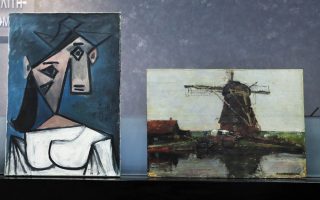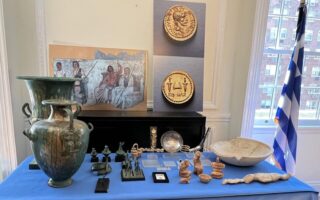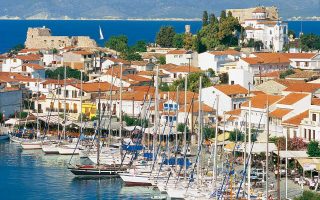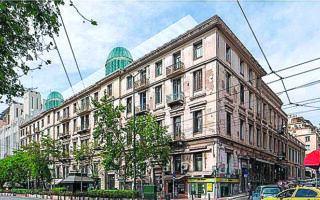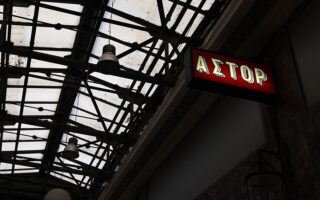A Balkan thriller with a ‘Jackson Pollock’
How the attempted sale of a painting that some are attributing to the famed American artist in Bulgaria led to a police operation in Athens
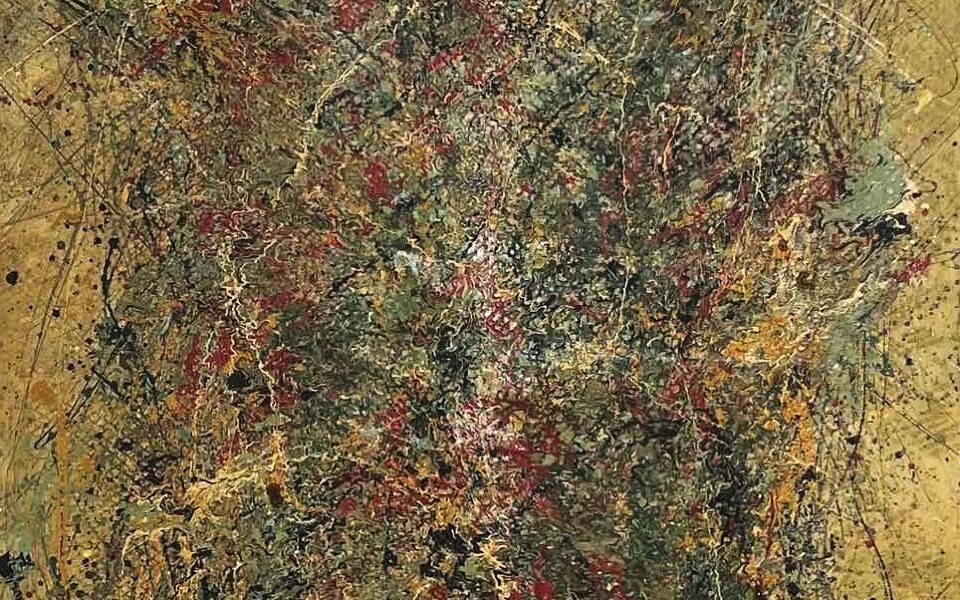
Heavily armed officers from Bulgaria’s organized crime unit discovered a painting that looked like it might be the work of the famous American painter Jackson Pollock during a search in Sofia on February 18. There was a dedication written on the back to the actress Lauren Bacall, as well as a signature in Romanian. Prior to being discovered in the Bulgarian capital, the painting – whose authenticity is still being investigated – was in Athens, in the possession of a Greek family.
The news of the discovery of what is possibly an uncatalogued piece by Pollock has been making the rounds of the world in recent weeks. Bulgarian Interior Minister Ivan Demerdzhiev has claimed that the painting was part of the private collection of Nicolae Ceausescu, while also expressing confidence that it is authentic. His reference to the late Romanian dictator prompted a response from that country’s culture minister, Lucian Romascanu, who said that authorities in Bucharest will seek the painting’s repatriation if its authenticity is confirmed.
But how did the painting get from Athens to Sofia, and what’s the connection between Ceausescu and Greece? Kathimerini sought to shed light on this mysterious affair.
Romanian connection
According to Bulgarian media, Ceausescu gave the painting to a trusted military officer before his execution in 1989. The officer’s daughter married a Greek and the painting ended up in Athens a few years later. Having found the officer’s name, Kathimerini confirmed that it was an actual person from historian Stejarel Olaru, who has studied the archives of the Romanian State Security Department during the dictatorship. The records show a colonel of that name who was discharged in 1982. “Most of the Ceausescu family’s paintings were confiscated in 1990, but his heirs managed to get them back several years later through the courts. They were signed by famous Romanian painters, though. I don’t know anything about a Pollock,” says Olaru, adding that he does not exclude the possibility.
Kathimerini contacted the person who had the painting in Athens, who preferred not to comment as the case is still open. According to one – unconfirmed – version of events, however, the Romanian officer had gained Ceausescu’s favor by saying that he could guarantee his safety.
We do not know whether the Bulgaria’s organized crime unit was responding to a complaint. The department has only reported that the police was investigating a shady art deal. This, according to one scenario, involved a man from Crete with business ties in Bulgaria who allegedly brought the Greek “owner” of the painting in touch with a Bulgarian “art expert” who would help him sell the painting. A Pollock that has been authenticated can fetch millions of euros; one that has not may go for a few thousand. Either way, the price depends on whether the buyer believes in its authenticity.
The nearly 2-meter tall painting was transported by road to Bulgaria, though it is not yet certain whether a license for its export had been secured from the Greek National Gallery, as stipulated by law. During the Sofia operation, police arrested the Bulgarian go-between and three Greek nationals. The Bulgarian authorities contacted Europol to reach out to police in Crete, as two of the suspects hail from the island. Crete police officers then traveled to Athens where they carried out searches on two apartments and a storage unit on the morning of February 19. The seized paintbrushes, stamps and several paintings bearing the signatures of Greek and foreign artists. A police source told Kathimerini that the paintings are being examined for authenticity, but did not specify by whom.
A member of the Greek family that previously had the Pollock was kept in custody for 24 hours in Bulgaria before being released without charge, according to his lawyer. Kathimerini has learned, meanwhile, that members of the same family have taken legal action against two art historians in the past for doubting the authenticity of art they had sold.
Judicial authorities in Sofia say that an initial analysis of the painting has found similarities in the colors with those used by Pollock. However, the official committee of experts in Bulgaria has noted, according to media reports, that this is nowhere near enough to confirm authenticity. “We cannot provide any additional details as the investigation is still under way,” a spokesperson for Bulgaria’s National Gallery told Kathimerini.
‘Most of the Ceausescu family’s paintings were confiscated in 1990, but his heirs managed to get them back several years later through the courts’
“Even if this work is authentic, which I highly doubt, there is really no market for an unprovenanced Jackson Pollock because there is no authenticating body,” Colette Loll, the founder and director of the consultancy firm Art Fraud Insights, which specializes in identifying fake artworks, told Kathimerini.
“If this work was from a legitimate collection, if it belonged to a famous American actress, there would be a record of it. It would exist in a photograph, in estate papers, in someone’s memory, it would exist somehow,” she added.
One of the more high-profile cases Loll has been involved in concerned a dispute between Pollock’s widow, painter Lee Krasner, and his mistress, Ruth Kligman, over the provenance of a piece the latter claimed had been painted for her in the summer of 1956, just a few weeks before Pollock was killed in a car crash. Experts at the Pollock-Krasner Foundation rejected Kilgman’s claims and refused to add the piece to its catalogue.
Nicholas Petraco, a forensic sciences professor at the John Jay College of criminal justice and a former New York police detective, was also involved in that case.
“Of the more than 100 paintings attributed to Pollock that I have examined, only one was authentic,” he told Kathimerini.
Among other things he looks at Petraco examines traces of hairs, fibres, dust and other particles that may have become trapped by the paint. In the case of the Kligman painting, he found a polar bear hair that was perplexing at first, until he found a rug made of a polar bear pelt in the attic of Pollock’s East Hamptons house. The discovery was a strong indicator of where the painting may have been done.
“Even Ruth Kligman’s painting, which has a rock-solid provenance, has not been fully accepted in the art market despite the overwhelming evidence to its favor. Because the art market is risk averse,” noted Loll. “There are many very legitimate Pollock works that have been stuck in painting purgatory because they don’t have provenance.”
Petraco expresses doubt about the authenticity of the painting discovered in Bulgaria, noting that “forgers usually try to replicate Pollock’s motion, while using paints and canvas from that era,” which can be purchased online. He says the painting needs to be looked at in greater detail, including the paint resin, paint pigments and canvas, while a handwriting analysis should also be carried out of the signature.
“There is a mythology around Jackson Pollock because he was a heavy drinker and he gave a couple of paintings away when he was living in Palm Springs to settle some debts,” said Loll, adding, however, that she thinks this only might have happened once or twice.
“People think that art fraud is a victimless crime, it’s just rich people getting ripped off, but the fact is it’s a crime against the art historical record. If something is inserted into an artist’s body of work that doesn’t belong there, it takes a place in history that it hasn’t earned and it can affect art history and data sets and the way we look at an artist’s body of work for generations to come. I look at these as crimes against culture,” Loll added.
